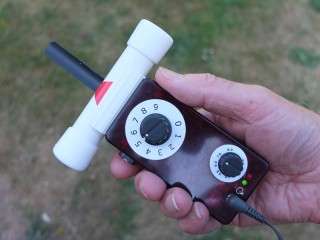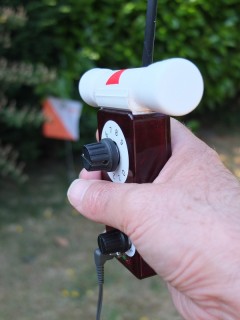Compact 80m Direct Conversion ARDF receiver
nb. see footer notes

This design was inspired by the innovative SM5CJW receiver.
The form factor is much smaller and lighter than other designs. The ergonomics are very good, and the receiver is easy to operate using a single hand, so it is an ideal receiver suitable for a beginner or orienteer.

After building and experimenting with the SM5CJW design , a modified version incorporating personal preferences has inevitably evolved.
Here are the key differences.
- Front-end cascode amplifier with gain control (from a design by WB6BYU).
- VXO using a Ceramic resonator.
- Conventional ferrite rod winding and sense antenna.
The receiver form factor and audio amplifier is the same as in the SM5CJW design.
My original build used a VFO and had unacceptable drift .
I was advised by SM5CJW that very few smd chip inductors are, in fact, suitable for a VFO. I had no great stock of inductor chips which I could compare for stability testing, so I started looking at the use of a ceramic resonator in a VXO circuit, as an alternative. The final design gives a repeatable VXO range of at least 60kHz covering 3.52Mhz to 3.58Mhz.
This frequency range is fine for UK event usage, but it must be noted that it may not be suitable for international events, particularly foxOring and sprint, where a band spread of 3.51 to 3.6Mhz may be used. (see footer).
The big advantage of the VXO is rock-solid stability with a low sensitivity tuning rate, making it ideal for beginners (and me!).
As this receiver uses the same front end as the Dale Hunt, WB6BYU receiver you could use his loop antenna design instead of a ferrite rod. click here for details.
Documents available, updated 2-Nov-2014
- Component layout
- PCB wiring
- Box preparation and drilling.
- Winding details for toroid L1.
- Antenna rod and tube enclosure.
- BOM
Footer Notes, updated 03-June-2021
- Replacing the BB201 varicap diode with a BBY66 should increase the pulling range of the VXO.
- I have a similar newer unpublished 80m RX design , using through hole components. If interested, please contact me using the mail address on my home page.
